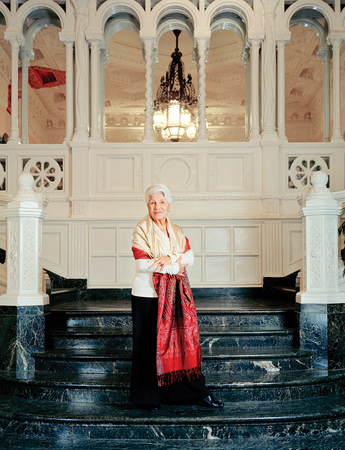
R
E
V N
E
X
T
The Monir Museum, dedicated to the six-decade-long career of artist MONIR SHAHROUDY FARMANFARMAIAN, opened on December 15, 2017, in Tehran. Courtesy Monir Museum.
A museum devoted to the life and six-decade-long career of artist Monir Shahroudy Farmanfarmaian opened on December 15, in the historic Negarestan Museum Park Gardens in Tehran. The Monir Museum, under the auspices of the University of Tehran, houses more than 50 artworks that the artist gifted to the university. The artworks and objects span Farmanfarmaian’s career, from her reverse-painted glass works and mirror mosaics fusing midcentury modernism with Persian, Qajar-era interior decorations, to her drawings, original carpets and jewelry. Among the donations were works from Farmanfarmaian’s 1990s “Heartaches” series of sculptural boxes made of photographs, prints, and various objects in memory of her late husband, Abolbashar Farmanfarmaian, from their life in New York. It is the first museum in Iran dedicated to a single female artist.
Now 93 years old, and still actively producing artworks, Farmanfarmaian has led a storied life. She spent her formative artistic years in New York, moving there in 1945, and where she met many artists of the New York School. She and her husband returned to Iran in 1957, and there she began to collect Turkoman jewelry and coffee-house paintings in an effort to preserve these vernacular art forms that were being lost as the country modernized. Her own artworks developed throughout these decades, as she began to use mirror-mosaics—utilizing a technique called aineh-kari, which dates back to the 16th century—and reverse-painted glass to create large panels, evoking the sublimity of Islamic geometry.
Throughout the 1960s and 1970s she exhibited throughout Tehran and abroad, participating in the Iran Pavilion at the Venice Biennale in 1958, 1964, and 1966, and in solo presentations in New York and Paris. The 1979 Islamic Revolution forced her into exile, and she and her husband relocated to New York for another 25 years before returning to Tehran in 2004, to reopen her studio. She has since held solo exhibitions at the Victoria and Albert Museum in London; Fundação de Serralves, Porto, Portugal; the Solomon R. Guggenheim Museum in New York; and the Savannah College of Art and Design Museum. In 2009, she produced a major commission, Lightning for Neda, for the sixth Asia Pacific Triennial at the Queensland Art Gallery | Gallery of Modern Art in Brisbane, as well as participating in gallery shows in Dubai and many group exhibitions exploring postwar and contemporary Iranian art.
The Monir Museum is located in a complex of 19th-century buildings, Old Fathali Shah, in the Negarestan Museum Park Gardens, also home to the University Museum of Iranian Art. The Qajar-era architecture of the building appropriately reflects her works’ references to Iranian cultural heritage. The interiors of the space, redesigned by architect Reza Najafian, allow Farmanfarmaian’s creations to shine in unison, in a rich survey of her practice.
HG Masters is the editor-at-large of ArtAsiaPacific.
To read more articles by ArtAsiaPacific, visit our Digital Library.




